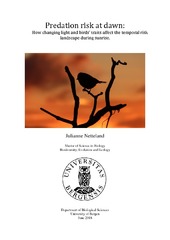Predation risk at dawn: How changing light and birds’ traits affect the temporal risk landscape during sunrise.
Abstract
Passerine birds, commonly known as songbirds, have a pronounced peak of singing before sunrise during their breeding season, known as the dawn chorus. This thesis aims to explore why they sing at this time – what are the physiological and behavioral drivers, and what are the important temporal changes when determining the risks and opportunities before, during, and after sunrise? Predation risk might be a key factor in determining the onset of the dawn chorus, and the risk birds experience during dawn song is dependent on their behavior and physiology, as well as that of both diurnal and nocturnal predators. However, few studies have looked at and compared the activity patterns of both predators and prey birds, or have addressed predation on dawn-singing birds. If predation risk varies temporally or spatially, we would expect songbirds to respond by changing their niches or habitats. This work is conceptual, and pieces together knowledge from diverse fields, inferring the missing parts. In the following, I build my argument through a series of questions. Each question will look into a factor that could have an effect on the predation risk experienced by songbirds, and ultimately help explain the dawn chorus. Based on the answers to these questions, I present the hypothesis that songbirds make use of a temporal window of opportunity prior to sunrise, where the light environment results in a lower predation risk for the singing birds. This hypothesis is based on data collected from previous work on the visual constraints birds experience at various light environments. The possibility of a temporal window of opportunity gives a new view on what determines and limits the onset of dawn song for passerine birds. Trade-offs in the eye, which are correlated with different foraging strategies, will in part determine the temporal placement and duration of this window. Latitude and season will also determine the extent of, and thereby the ecological importance of the window of opportunity.
